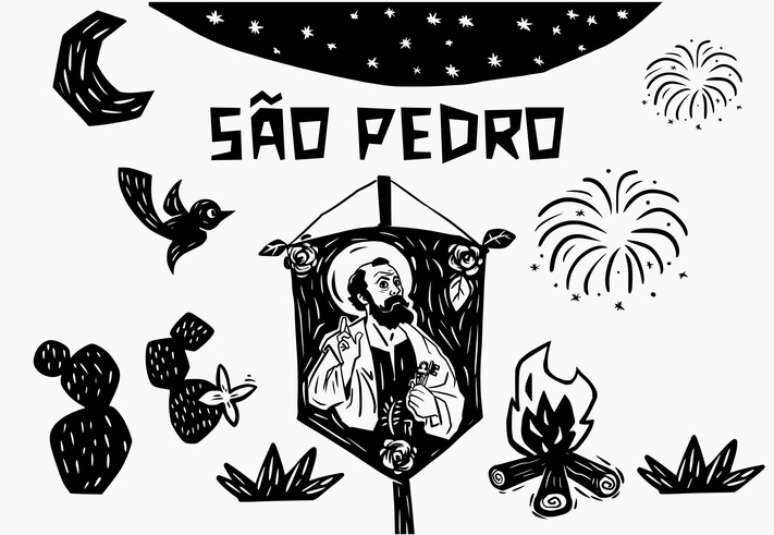Discover the fascinating history of St. Peter and learn more about this June saint, his role in the history of the Church and much more!
html[data-range=”xlarge”] figure image img.img-484ab74408f03dfd03e89e4428e415df07z7hfwv { width: 774px; height: 535px; }HTML[data-range=”large”] figure image img.img-484ab74408f03dfd03e89e4428e415df07z7hfwv { width: 548px; height: 378px; }HTML[data-range=”small”] figure figure img.img-484ab74408f03dfd03e89e4428e415df07z7hfwv, html[data-range=”medium”] figure image img.img-484ab74408f03dfd03e89e4428e415df07z7hfwv { width: 564px; height: 389px; }
A history of saint peter it is of great significance and celebration to believers around the world. On this special day, believers reflect and honor the life and legacy of one of Jesus Christ’s most important apostles.
São Pedro is one of the three saints celebrated in the Festa Junina, along with Santo Antônio and São João. He is recognized as the founder of the Christian Church in Rome and the first pope, but his importance goes beyond religious matters. He has become a cultural icon and a revered figure in many popular traditions.
What is the history of San Pedro?
The history of São Pedro is fascinating and full of meaning. He is a saint who began his life in an ordinary way, he was born in a very small village in northern Israel, called Bethsaida, which is located on the shores of Lake Gennesaret.
His real name was Simon, he was a fisherman and lived in Capernaum, an important city in the region.
Everything changed when Simon met Jesus. It was during this meeting that Jesus said to him: “You will take men”, inviting him to follow him. Simon accepted the calling and became a disciple of Jesus. Later, Jesus gave him the name Peter, which means “Rock” in Aramaic.
Peter played a key role in the life of Jesus and in the history of the Church. He was one of Jesus’ principal apostles, testifying to his teachings, miracles, and resurrection. Peter was also the first head of the Christian Church, being recognized as the first pope.
Pedro has also faced difficult times in his journey. While in captivity, Jesus denied knowing him three times, fulfilling a prophecy made by Jesus. However, Peter repented bitterly, and after Jesus’ resurrection, he received forgiveness and restoration from the Master.
After being empowered by the Holy Spirit at Pentecost, Peter became a courageous preacher and an influential leader in spreading the gospel.
He traveled extensively, evangelizing and strengthening Christian communities. Peter also wrote two letters which are present in the New Testament, encouraging the faithful and instructing them in their faith.
Devotion to St. Peter transcends religious boundaries. He is revered not only by Catholics but also by many other Christian traditions and is considered one of the pillars of the Church.
His humility, faith and devotion to Jesus are inspiring examples for all Christians.
Therefore, the history of St. Peter is marked by his transformation from a fisherman to an apostle and leader of the Church. His journey of faith, repentance, and redemption is a powerful reminder of God’s love and mercy.
Celebrating Saint Peter is an opportunity to meet and be inspired by this important figure in the history of Christianity.
Why is June 29 the feast of St. Peter?
June 29 is celebrated as St. Peter’s Day. This date was chosen in reference to the Catholic tradition of celebrating the martyrdom of Saint Peter and Saint Paul, both considered the principal saints of the Christian Church. In the liturgical calendar, St. Peter is honored on that particular day.
The celebration of the martyrdom of St. Peter has its roots in stories handed down by the Christian tradition. According to her, Peter was crucified upside down in Rome, at his request, because he deemed himself unworthy to die in the same way as Jesus.
This last act of devotion and sacrifice made Saint Peter a revered martyr and his memory is celebrated on June 29th.
The choice of this specific date to honor him is linked to the fact that, according to tradition, both São Pedro and São Paulo were martyred in Rome during this period.
Why does St. Peter have a key in his hand?
One of the best known representations of St. Peter is to see him holding a key. This image symbolizes the power and authority given to him by Jesus Christ.
That is, according to Catholic tradition, this symbolic representation is associated with specific meanings:
- Authority granted by Jesus: According to the Bible, Jesus told Peter, “And I will give you the keys of the kingdom of heaven; and whatever you bind on earth shall be bound in heaven, and whatever you loose on earth shall be loosed in heaven.” (Matthew 16:19). The key represents the authority given to Peter to govern the Church.
- Command Role: The key also represents Peter’s leading role as the first pope and founder of the Christian Church in Rome. He was entrusted with the responsibility of leading and governing the community of believers.
Thus, this iconic image of St. Peter holding a key reminds us of the importance of his position as a spiritual leader and the authority entrusted to him.
It symbolizes his mission to open the doors of faith and lead the faithful on the way to salvation.
What does St. Peter represent?
St. Peter’s is known as the rain and village saint, being especially revered in agricultural and rural regions. Its association with rain goes back to ancient folk traditions that believed it he had the power to control the weatherbringing the rains to the fertility of the earth.
In this context, São Pedro is considered a protector of farmers and responsible for ensuring good harvests.
With that, it is common to find processions, dances and rites related to the search for rain during the June festivities in various parts of the world. The main petitions to St. Peter are to bless the earth with abundant water, to ensure the success of the plantations.
Furthermore, St. Peter is often depicted with childlike features, as a friendly and welcoming figure. This representation is associated with the fact that Peter was one of Jesus’ closest disciples and shared a relationship of trust with him.
The close relationship between Saint Peter and Jesus is often portrayed in biblical stories, where Peter is shown as a devoted student, but also as someone who has demonstrated failures and doubts along the way.
This humanized representation of St. Peter makes it more accessible and inspiring for believers, as it demonstrates that even religious leaders can face challenges and uncertainties. St. Peter is also known for his zeal and his commitment to spreading the Gospel.
After Jesus’ death, they became a central figure in the spread of Christianity, traveling to various regions to spread Jesus’ teachings. Their courage and determination in the face of danger and persecution are examples of devotion and dedication to the faith.
St. Peter is still remembered for his ability to perform miracles. Popular stories describe healings, deliverances and other miraculous feats attributed to his intercession. These accounts strengthen faith in the intercession of the saints and inspire the faithful to seek the spiritual help of St. Peter in times of need.
In the context of the June festivities, São Pedro plays a special role as the patron saint of the celebrations. Its celebrations are marked by popular dances, typical foods, bonfires and lots of fun.
people if gather in communities and parishes to honor St. Peter and thank you for the blessings received, as well as asking your intercession for protection, prosperity and good harvests.
Did you like the content? How about taking advantage of the São Pedro fiesta to prepare delicious typical foods? Go to Degusta and discover the recipes of typical foods!
Source: Terra
Ben Stock is a lifestyle journalist and author at Gossipify. He writes about topics such as health, wellness, travel, food and home decor. He provides practical advice and inspiration to improve well-being, keeps readers up to date with latest lifestyle news and trends, known for his engaging writing style, in-depth analysis and unique perspectives.








